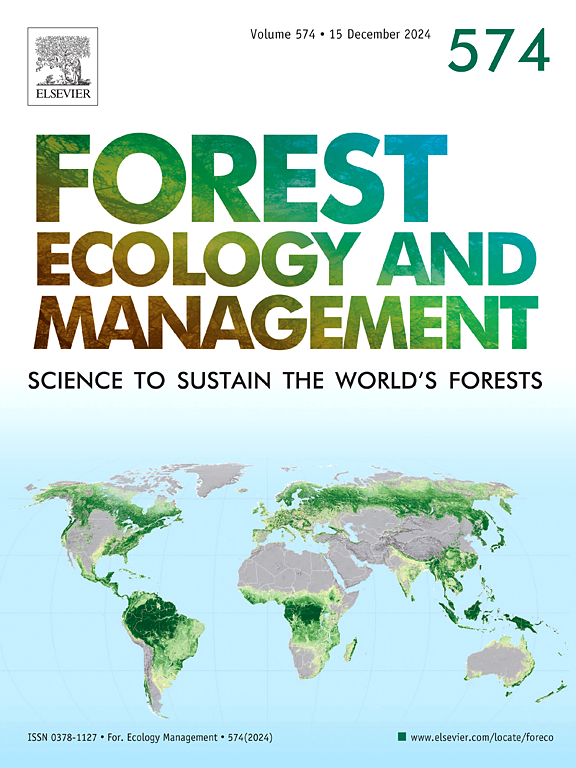First-year tree seedling dynamics in floodplain forests of the Lower Mississippi Alluvial Valley
IF 3.7
2区 农林科学
Q1 FORESTRY
引用次数: 0
Abstract
Complex dynamics within the regeneration process limits floodplain forest tree species composition. These complexities include how the stages of regeneration (i.e., seed production, dispersal, germination, establishment, and survival) interact with components of the floodplain hydroperiod (e.g., flood duration, water level, timing, frequency), which historically created both regeneration opportunities and limitations through time and space, resulting in a wide array of species composition patterns in early regeneration stages. We examined the relationship between first-year tree seedling emergence and flood patterns across four floodplain sites within the Lower Mississippi Alluvial Valley (LMAV). We established eight water-level monitoring stations to measure flood depth and duration at each site, and surveyed seedlings every two weeks across 21 plots (20 m x 20 m). We documented a total of 15,832 first-year seedlings, representing 17 species and two genera across the three growing seasons. We found that both the time of year and the timing of flood recession were important predictors of species-specific emergence. Lighter-seeded species’ (e.g., Ulmus) probability of emergence was higher immediately following a flood event (0–50 d) as compared to later dates (>50 d). Only one of the three heavier-seeded Quercus spp. showed a significant positive response to flood recession. Water level also affected emergence probability with lighter-seeded species, such as Ulmus spp. and Fraxinus pennsylvanica, showing a more immediate positive response to water at or near the soil’s surface. Overall, this study demonstrates that flooding can obstruct the germination window of a given species by reducing or eliminating its emergence probability, or it can improve emergence probability through properly timed flood recessions. Dynamic flood conditions across space and time likely contribute to increased diversity of first-year seedling composition in the LMAV. However, disruption of historic flood patterns and drying of floodplains may trigger significant changes in the seedling layer that have long-lasting effects on the floodplain forest species composition.
密西西比河下游冲积河谷洪泛区森林第一年树苗动态
更新过程中的复杂动态限制了漫滩森林树种组成。这些复杂性包括再生阶段(即种子产生、扩散、萌发、建立和生存)如何与洪泛区水期的组成部分(如洪水持续时间、水位、时间、频率)相互作用,这些组成部分在历史上通过时间和空间创造了再生机会和限制,从而导致早期再生阶段的物种组成模式的广泛多样性。我们研究了密西西比河下游冲积河谷(LMAV)四个洪泛区的第一年树苗出苗率与洪水模式之间的关系。我们建立了8个水位监测站,测量每个站点的洪水深度和持续时间,并每两周对21个地块(20 m x 20 m)的幼苗进行调查。本研究共记录了15832株一年生幼苗,分布在三个生长季节的17种2属。我们发现,一年中的时间和洪水退潮的时间都是物种特异性出现的重要预测因子。较轻种子的树种(如榆木)在洪水事件发生后(0 ~ 50 d)立即出现的概率高于较晚时间(50 d)。3种重种子栎中只有一种对洪水衰退表现出显著的积极响应。水位也影响轻种子物种的出苗率,如榆木(Ulmus spp.)和宾夕法尼亚白曲霉(Fraxinus pennsylvania),它们对土壤表面或接近土壤表面的水表现出更直接的积极反应。总体而言,本研究表明,洪水可以通过降低或消除特定物种的出苗率来阻碍其萌发窗口,或者通过适当的洪水衰退来提高出苗率。跨越时空的动态洪水条件可能有助于增加LMAV一年生幼苗组成的多样性。然而,历史洪水模式的破坏和洪泛区的干燥可能引发幼苗层的显著变化,对洪泛区森林物种组成产生长期影响。
本文章由计算机程序翻译,如有差异,请以英文原文为准。
求助全文
约1分钟内获得全文
求助全文
来源期刊

Forest Ecology and Management
农林科学-林学
CiteScore
7.50
自引率
10.80%
发文量
665
审稿时长
39 days
期刊介绍:
Forest Ecology and Management publishes scientific articles linking forest ecology with forest management, focusing on the application of biological, ecological and social knowledge to the management and conservation of plantations and natural forests. The scope of the journal includes all forest ecosystems of the world.
A peer-review process ensures the quality and international interest of the manuscripts accepted for publication. The journal encourages communication between scientists in disparate fields who share a common interest in ecology and forest management, bridging the gap between research workers and forest managers.
We encourage submission of papers that will have the strongest interest and value to the Journal''s international readership. Some key features of papers with strong interest include:
1. Clear connections between the ecology and management of forests;
2. Novel ideas or approaches to important challenges in forest ecology and management;
3. Studies that address a population of interest beyond the scale of single research sites, Three key points in the design of forest experiments, Forest Ecology and Management 255 (2008) 2022-2023);
4. Review Articles on timely, important topics. Authors are welcome to contact one of the editors to discuss the suitability of a potential review manuscript.
The Journal encourages proposals for special issues examining important areas of forest ecology and management. Potential guest editors should contact any of the Editors to begin discussions about topics, potential papers, and other details.
 求助内容:
求助内容: 应助结果提醒方式:
应助结果提醒方式:


